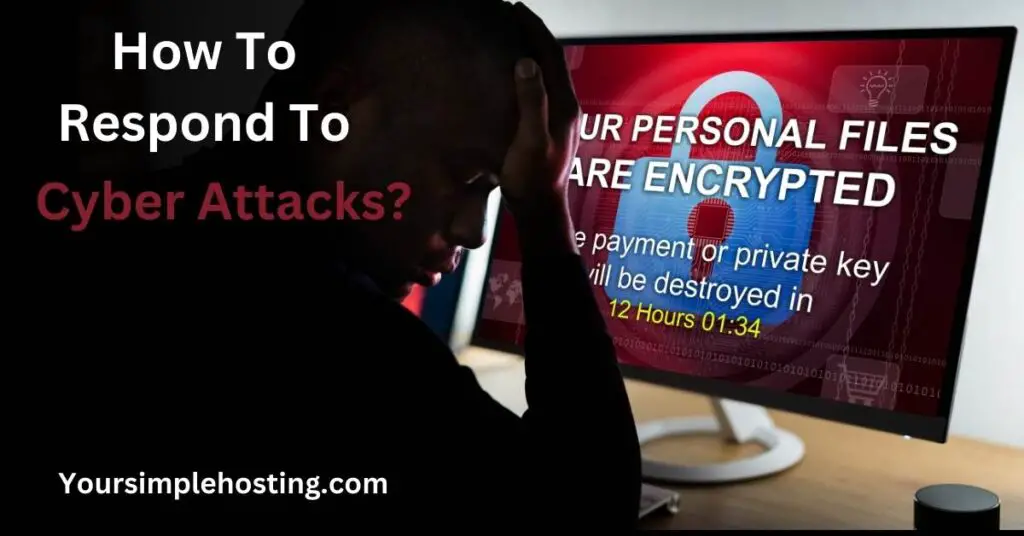Even a slight vulnerability in a cyber security system is enough to wreak havoc on any business’ reputation and result in thousands of dollars worth of damage. However, there is no such thing as a perfect security system.
While the target is to avoid a cyber attack altogether, how quickly and efficiently you respond to such a breach can mitigate the damage and allow you to develop a better cyber security response plan to contain such attacks in the future.
Ensure you have a process in place for dealing with cyber attacks, and each team and individual understands their role and responsibility. Having a process in place will allow you to respond to cyber attacks and eliminate the threat quickly.
In this article, I will outline the steps required for creating a response plan that should follow if you fall prey to a cyber attack.

Table of Contents
5 Immediate Steps To Take In Case Of A Cyber Attack
Whether a business is big or small, there needs to be a clear assignment of roles and responses in case of a cyber attack to avoid confusion – quick actions can help vastly contain the impact of a cyber breach.
Here are five steps to take when someone breaks through your organization’s security system.
Step 1: Survey – Understand the Type of Attack You Are Facing
Different types of cyber attacks require different responses. Knowing what kind of attack you are dealing with will help you determine the best course of action. A dedicated security team must survey the attack to identify the damage and how it will impact crucial business operations.
To understand the severity of the attack, the investigative team must ask the following questions:
- How did the breach initiate?
- What kind of information was accessed?
- Have any credentials changed?
- Which business functions are affected?
Finding answers to these questions helps determine the steps to limit the damage and the type of assistance you may need.
You can hire third-party forensic experts if you do not have a security team to assess the attack and subsequent damage.
Step 2: Contain – Limit the Effects of the Cyber Attack
Once an attack has been identified, taking immediate steps to limit its spread and reduce any potential damage is essential. This may include disconnecting affected systems from the network, disabling vulnerable services or applications, and restoring backups from before the incident occurred.
Unless advised by the cybersecurity team or third-party experts to resume regular activities, you should also restrict access to physical areas that may be affected by the breach. Preventing access will help reduce the attack’s spread, limiting devices or users’ ability to connect to the affected system or network.
Moreover, once your security team allows, take all compromised systems offline to prevent further information loss.
Additionally, you must ensure the removal of any stolen information posted online.
Step 3: Record – Make Logs of All Incident Responses
It is essential to investigate a cyber attack to understand how it happened, who was responsible for it, and what data may have been compromised or stolen. This can be done by examining system logs, analyzing network traffic patterns, and conducting forensic analysis on affected systems.
Keep a detailed account of all the actions and responses resulting from the security breach to help reflect on mistakes and plan a more efficient course of action in similar situations.
Such logs serve as a knowledge base, including information about compromised systems, services and accounts, and the affected network and data. Also, document steps taken to neutralize the attack and how the same could have been dealt with more efficiently.
Step 4: Notify – Engage Legal Entities
Depending on the severity of an incident, organizations may need to notify law enforcement agencies such as police departments or government bodies like CERTs (Computer Emergency Response Teams). Doing so can help ensure that appropriate measures are taken against those responsible for carrying out the attack.
Most commonly, businesses do not know when and how to notify authorities. Confusion can be avoided by contacting related legal entities before an attack when strategizing an incident response plan. This course of action gives you a clear idea of what evidence to report. Depending on the type of information stolen, law enforcement agencies may stop the media from releasing it to the public.
Step 5: Disclose – Inform All Stakeholders of the Breach
You must disclose details of the attack to all stakeholders, including customers and other organizations if their information is disclosed, lost, or stolen. Ensure you know the state laws on notification when such breaches occur.
Being transparent with all stakeholders allows them to take necessary steps to avoid fraudulent usage of their information. However, consult law enforcement (if involved) to time the notification so that it does not impede the investigation in any way.
While you cannot always prevent a cyber attack, your response and transparency when dealing with the aftermath will significantly impact how customers and partners view your business in the future.

Lessons To Take From A Cyber Attack: Developing an Effective Response Plan
After responding to a cyber attack, it is important to put measures in place to prevent similar incidents.
With the increasing frequency of cyber attacks, taking organization-wide steps to learn from such incidents is prudent. Some procedures that allow more efficient handling of such responses include documenting mistakes, identifying how they could have been avoided, and incorporating these lessons in drills to improve the incident response plan.
Ensure that all actions taken are rehearsed to avoid costly mistakes and confusion.
Moreover, keep the plan current and identify what industry assets may be under threat depending on value.
Once you have a response plan in place, you can focus on post-attack recovery. Again, documenting every step, all mistakes, and proposed improvements help build credibility and confidence throughout the organization for a quick and effective response.
Quick Checklist On How To Respond To Cyber Attacks
1. Identify the source of the attack.
2. Assess the damage caused by the attack.
3. Take steps to contain and mitigate any further damage.
4. Implement security measures to prevent similar attacks in the future.
5. Notify relevant authorities, such as law enforcement or government agencies, if necessary.
6. Document all details related to the incident for future reference.
How To Prevent Cyber Attacks: What You Need To Do
Ideally, an organizational approach towards cyber security attacks should focus on prevention rather than remediation. However, there are several ways in which you can place effective procedures to ensure anticipation and prevention of such breaches.
Here are some ways to invest in preventing cyber attacks.
- Investigate and learn about breach attempts to implement effective response strategies.
- Use VLAN technology to segment business on a network level to allow isolated investigations.
- Regularly monitor system logs for suspicious activity and use intrusion detection systems (IDS) or other monitoring tools to detect potential threats before they can cause harm.
- Use penetration testing to check and maintain network security.
- Monitor your network for suspicious activity and investigate any potential threats.
Conclusion
In case of a cyber attack, it is essential to have a structured response plan with all parties thoroughly well-versed in their roles. This allows you to survey the breach, take necessary steps to contain the damage, and inform stakeholders and law enforcement agencies to initiate recovery and data reconstruction. Moreover, documenting the process allows you to improve security and prevent such breaches in the future.

Leave a Reply